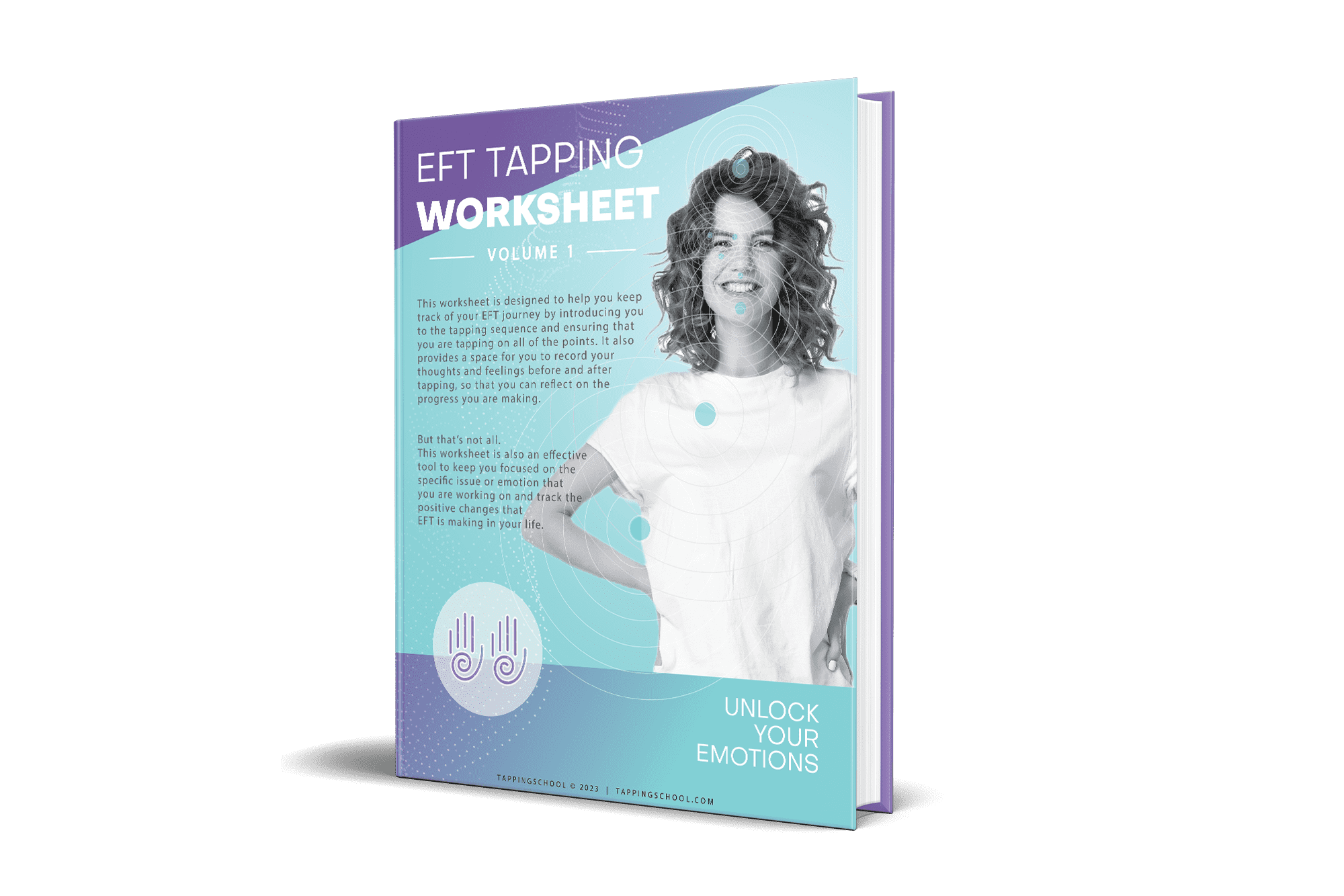EFT Tapping Worksheet PDF to Release Stress and Emotions
To get the most out of emotional freedom techniques or EFT, it is crucial that you conduct EFT tapping sequences correctly.
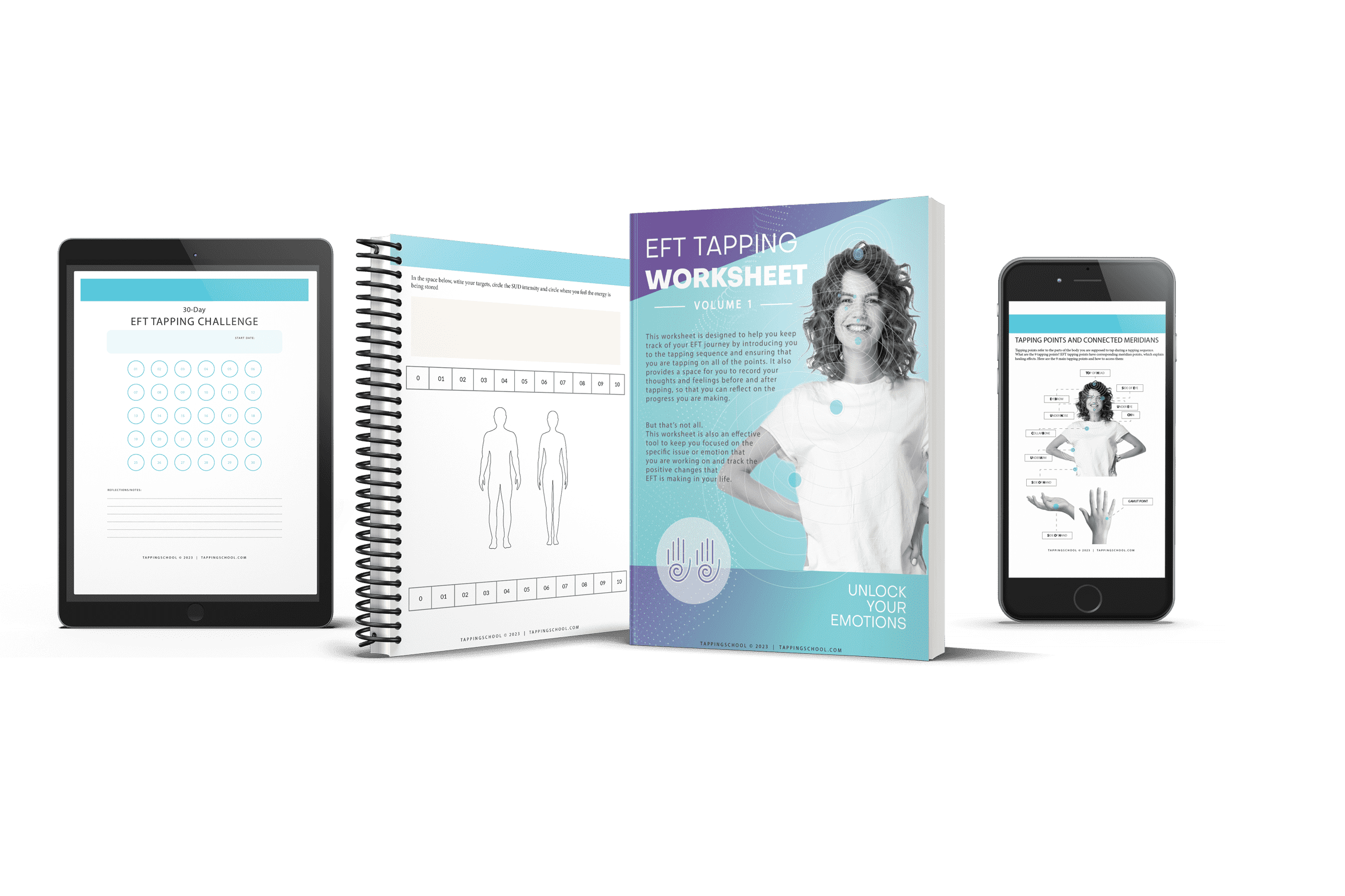
Our FREE printable EFT tapping worksheet is here to help guide you and navigate through the issue you wish to address with EFT. The information in this article will help you use the worksheet effectively and approach your EFT tapping journey with confidence.
At the bottom of this page, you’ll find information on how to access our FREE printable EFT tapping worksheet for personal use and how to book a free consultation with us if desired, as well as answers to frequently asked questions about EFT.
Key Points
Here are some key points you’ll find in this article:
- Gary Craig is known for developing EFT.
- EFT is an evidence-based practice that focuses on the mind-body connection.
- EFT tapping should be conducted in a clean, calm, and quiet space.
- Choosing a target for EFT tapping means pinpointing a specific emotion or thought you want to address.
- There are over nine tapping points with connected meridians.
- EFT worksheets can help you learn tapping sequences and get started.
Introduction to EFT Tapping and Its Benefits
EFT was founded by Gary Craig, a Stanford Engineer and student of Dr. Roger Callahan, in the 1990s. However, a large portion of the knowledge we employ when we use and teach EFT tapping has been around for much longer.
The origins of tapping are largely from Chinese medicine. Specifically, acupuncture, which has been around for roughly 3,000 years. If you think of acupuncture, you will notice that needles are inserted lightly in different points of the body to promote various healing effects based on what a person needs. For example, acupuncture may be used to provide relief from chronic pain, GI distress, anxiety, sleep issues, or something else. Acupuncture has been proven effective by many studies for all of these concerns and more.
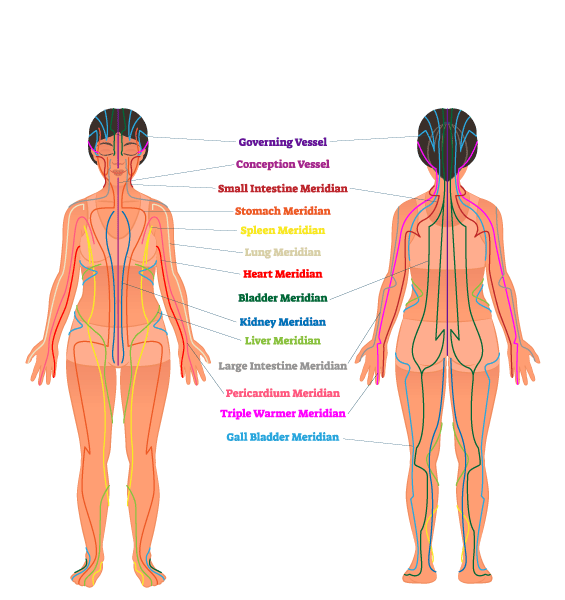
Like acupuncture, tapping work relies on scientific knowledge of the mind-body connection, and designated tapping points have specific uses or effects. This is why you will notice that different tapping sequences will prompt you to engage with different parts of the body, such as your head or hand. Also much like acupuncture, EFT tapping utilizes the body’s energy meridian points. However, with EFT tapping, the points are stimulated by tapping on them with the tips of your fingers.
Key Principles Behind EFT
Tapping on the energy meridian points sends signals to a part of the brain called the amygdala to calm down, relax, and relieve the fight or flight response.
One of the most special things about EFT tapping is that it combines cognitive reframing/restructuring techniques and exposure therapy techniques with all of the above. It is a way to address well-being with a whole-person approach.
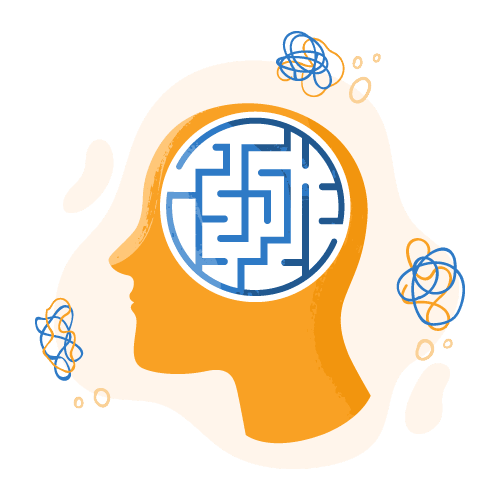
Preparing for EFT: Setting Up Your Space
In gaining an understanding of EFT for beginners, it’s important to learn how to prepare for tapping, choose a target, make a setup statement, and learn how to engage in the tapping process appropriately with proper use of the tapping points. Let’s start with how to prepare for tapping.
The EFT Tapping Sequence Explained
To get into the right headspace, you must prepare yourself and your space for an EFT tapping sequence. Ideally, you want to create a calm environment for yourself at this time. Here are three things to do as you prepare to use the EFT tapping worksheet or otherwise conduct a tapping sequence:

- Find a quiet space. Create a calm environment where everyone can feel safe and at ease. If you have them, you should use Himalayan pink salt lamps or fairy lights to create a warm, candle glow ambience. Taking a minimalist approach will facilitate focusing on emotional processing. Having gentle music or nature sounds at 432hz in the background may also help.
- Silence your phone or put it on airplane mode.
- Wash your hands.
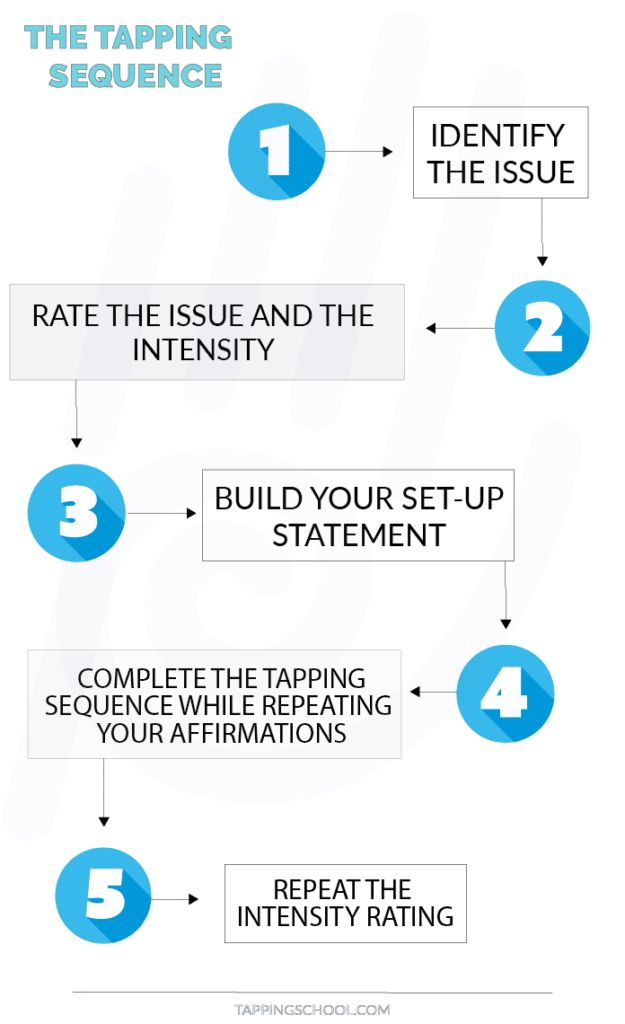
After that, you’re ready to choose a target.
Choosing A Target For EFT
EFT employs mindfulness and helps you get in touch with negative thoughts, beliefs, and feelings so that you can address them directly. EFT tapping sequences require that you choose a target, such as negative emotions or thoughts. That is why, upon preparing yourself and your space to start your tapping sequence, the next step is to choose a target for your session. For example, anxiety.
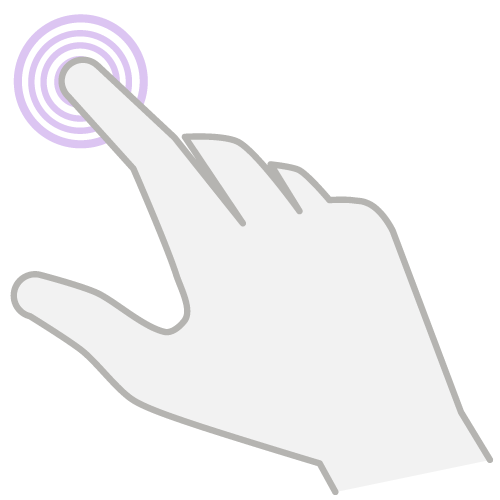
Once you pick a target, rate the intensity of the feeling or belief based on the SUDs (subjective units of distress) scale using the numbers 0-10. 0 marks the least distress, and 10 marks the most distressed. It is much like a “pain scale” that you’d see in a doctor’s office. You can use a different numeric range (e.g., 1-25) if it works better for you.
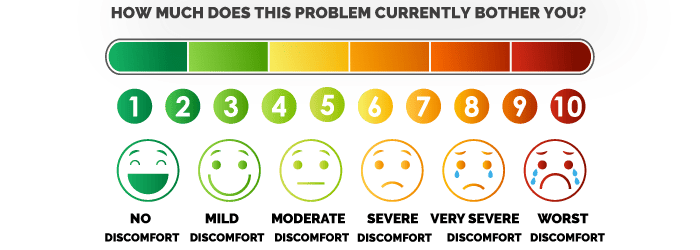
Some people also determine their tolerable level of distress so that they can set goals and identify distress before it becomes overwhelming so that they can use tools like tapping, breathing exercises, and other coping skills.
For example, perhaps you can tolerate an anxiety, stress, or overwhelm level of 3 on the SUDs scale, but not an 8. You might set the goal to get your distress down to a 3.
When you have picked a target and rated your level of distress, it’s time to create your setup statement and use it to start the tapping process.

Creating Your Set-Up Statement
Your setup statement should be unique to you and what you’re hoping to accomplish with EFT tapping. Using the formula below, you can build a powerful setup statement on your own whenever you have a new thought, feeling, or concern to address via tapping. The idea of the setup statement in the emotional freedom technique is to promote self-acceptance in spite of the concern you are dealing with.
Here is how to craft a setup statement:
- Identify the emotion. Using the section above, identify the emotion, thought, or belief you want to address. For example, “I’m nervous that my partner’s friends won’t like me.”
- Notice where you feel it in your body. Let’s say that you’re nervous. Do you feel butterflies in your stomach? Is any part of your body tense? Some people have an easier time with this than others.
- Add acceptance. Now, it’s time to tie your statement together, complete with acceptance. So, “Even though I’m nervous that my partner’s friends won’t like me and feel butterflies in my stomach, I deeply and completely accept myself.”
Two other examples of setup statements using this formula might be:
“While I’m worried about failing at work, I deeply and completely accept myself.”
“Although I feel overwhelmed, I deeply and completely accept myself.”
To start your tapping sequence, you will want to tap the KC (karate chop) point and say your setup statement out loud three times. Your EFT tapping worksheet will walk you through a full tapping sequence step-by-step.
Now what? At this point, you should have a basic idea as to how to start the tapping process. That said, you might still have some questions – such as what the karate chop point is.
Let’s go over where the karate chop point is, as well as other EFT tapping points. That way, you’ll have the knowledge required to follow any tapping sequence you want to use.
EFT Tapping Points And Connected Meridians
Tapping points refer to the parts of the body you are supposed to tap during a tapping sequence.
What are the 9 tapping points? EFT tapping points have corresponding meridian points, which explain healing effects. Here are the 9 main tapping points and how to access them:
- Under the arm (UA): Side of the body, 3-4 inches below the armpit. This point connects to the spleen meridian.
- Under the nose (UN): Between the upper lip and nose. This point connects to the governing vessel.
- Under the eye (UE): On the bone under either eye. This point connects to the stomach meridian.
- Side of the eye (SE): Outer corner of either eye. This point connects to the gallbladder meridian.
- Side of the hand (SOH): Outer edge of the hand (this point is also called “karate chop” or “KC”). This point connects to the small intestine meridian.
- Eyebrow point (EB): Inner eyebrow edge. This point connects to the bladder meridian.
- Top of the head (TOH): Crown of the head. This point connects to the governing vessel.
- Chin point (CH): Between the chin and lower lip. This point connects to the central vessel.
- Collarbone (CB): Just below the collarbone. This point connects to the kidney meridian.
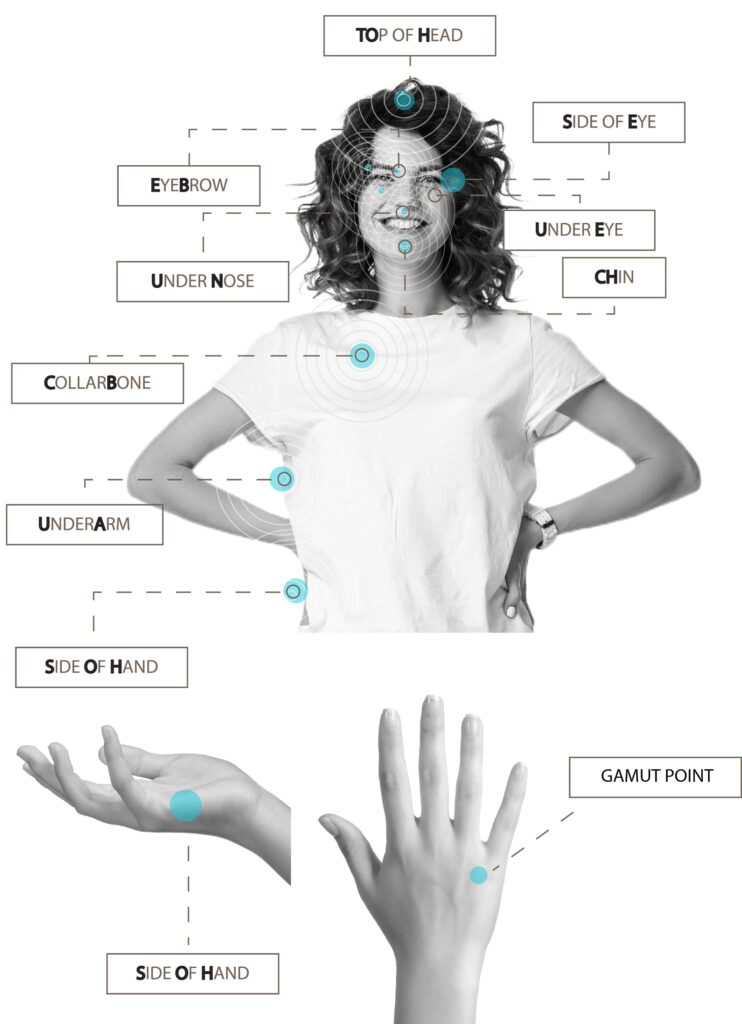
You may notice that tapping points are abbreviated in some instances. Refer to the abbreviations listed above if needed as you use your printable EFT tapping chart or otherwise engage in a tapping sequence.
During the tapping process, use two fingers or more to tap about five times on each point. Some tapping points have a twin point (like SE or EB), but it is only necessary to tap one side. For example, if the tapping point in question is SE, you’d only need to tap the outer corner of one eye.
Other tapping points
While the above tapping points are often used in tapping work, they aren’t the only tapping points. Two other tapping points you should know include the Gamut point and the Finger points. Here’s how to find them:
- The gamut point: The gamut point is located on the back of your hand between and directly behind the knuckles of your ring finger and little finger.
- Finger points: Finger points are located on the side of your middle finger, thumb, index finger, and little fingers at the base of your nail. To access finger points, start from your wrist on the side of your thumb, go up the side of your thumb to the base of the nail, and repeat with your other fingers.
In addition to what the tapping points are and how to access them, a frequently asked question those new to the emotional freedom technique have is how often to use it.

Advancing Your EFT Skills
If you need more guidance than a worksheet can provide, it may be ideal to work with an EFT practitioner. As far as how often you’ll work with an EFT practitioner goes, it’s common to meet with a practitioner on a weekly basis for around one hour per session while you’re learning. Some people only need a few sessions with an EFT practitioner, whereas others engage in weekly sessions for a few months or more. Working with a practitioner can help you feel confident in your tapping skills and find a routine that works for you. The goal of working with a practitioner is to obtain the skills you need to tap on your own.
A good EFT practitioner won’t make you reliant on their practice and will transfer knowledge to you. However, you may return to working with a practitioner at any point in time if you choose to do so as a means to learn more, brush up on your skills, get more emotional support, work through a problem you can’t solve on your own, or something else.
Not sure where to start? Learn the basics in our What’s EFT Tapping guide.
FREE WORKSHEET
EASY-TO-FOLLOW
EFT TAPPING WORKSHEET
This is essential for you to get results
